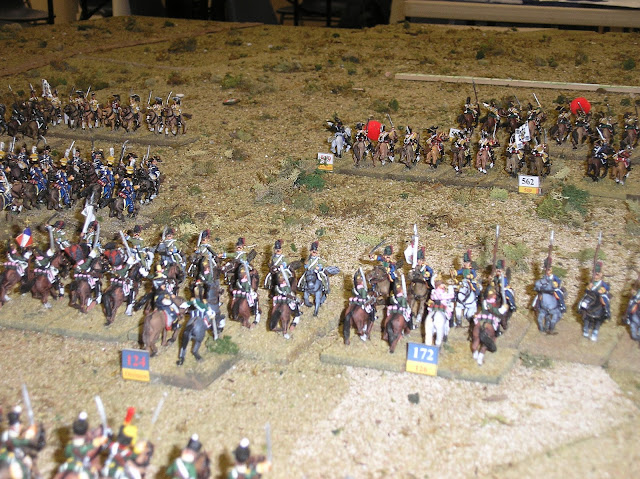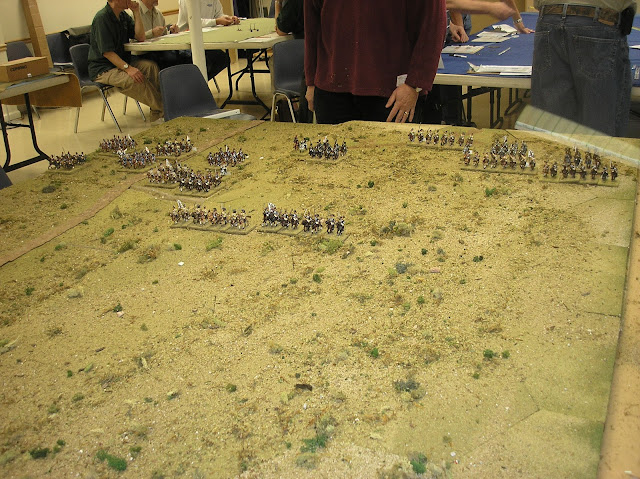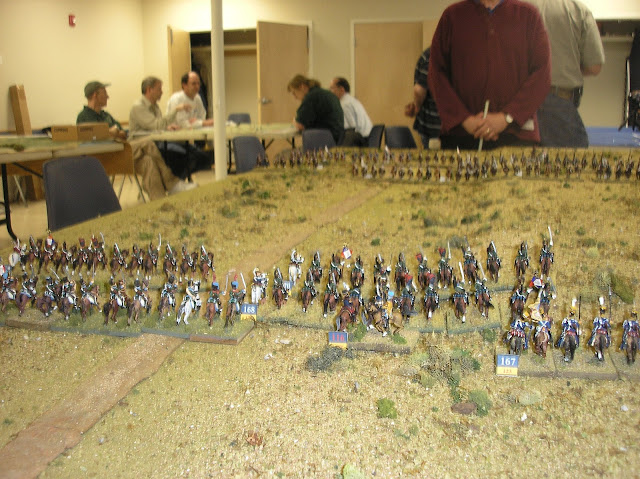The Battle of Ocaña of 19 November 1809 was a major Spanish defeat that ended any chance of success in the Spanish Junta’s autumn campaign of 1809. The Spanish plan involved two main armies – the Army of the Left operating around Salamanca and the Army of La Mancha. The idea was for the Army of the Left to draw the French reserves away from Madrid, allowing the Army of La Mancha an easy passage to the capital. A third much smaller Army of Estremadura had the job of holding two French corps in place on the Tagus. The Army of the Left had begin the campaign, even winning a battle at Tamames (18 October 1809), and drawing one brigade of infantry away from Madrid.
| Battle of Ocaña |
|---|
| Part of the Peninsular War |
|
| Belligerents |
|---|
 French Empire French Empire |  Spain Spain |
| Commanders and leaders |
|---|
 Nicolas Soult Nicolas Soult
Joseph Bonaparte |  Juan Carlos de Aréizaga Juan Carlos de Aréizaga |
| Strength |
|---|
| 40,000 Infantry, 6,000 Cavalry | 51,896 Infantry, 5,766 Cavalry |
| Casualties and losses |
|---|
| 2,000 dead or wounded | 4,000 dead or wounded,
14,000 captured |
The French force was officially commanded by King Joseph in person. By now Marshal Soult was serving as his chief-of-staff, with effective command of the army. Observing the Spanish retreat, Soult moved Mortier and Sebastiani towards Aranjuez, hoping to intercept Areizaga, while Victor was sent to cross the Tagus at Villamanrique. As a result Victor would miss the upcoming battle, leaving Soult with 33,500 men – 27,000 infantry, 6,200 infantry and 1,500 artillery and sappers. Despite his losses over the last week, Areizaga still had 46,000 infantry and 5,500 cavalry.
On 18 November the French cavalry crossed the Tagus at Aranjuez, and clashed with the Spanish cavalry around Ocaña. Despite being outnumbered, the French were victorious, but then discovered Spanish infantry in the town and pulled back to join the main French army.
That night Areizaga decided to offer battle, and took up a position on both sides of Ocaña, in a very weak position on a level plain. The Spanish left was covered by a ravine, but the right and centre was unprotected. The French cavalry would be able to operate freely around the Spanish right, and so Areizaga posted all but one of his cavalry brigades to protect that flank.
When Soult and King Joseph discovered the Spanish drawn up in line of battle, a debate broke out on whether the French should attack immediately, or wait for Victor, with Soult apparently in favour of waiting and Joseph determined to attack, on the grounds that the Spanish might leave overnight. If this was so, then for once Joseph was able to impose his will on one of his brother’s marshals.
Soult decided to attack the Spanish right with Sebastiani’s Polish and German divisions. Once the infantry was engaged, the French cavalry would drive off Freire’s Spanish cavalry and then attack the exposed Spanish flank. Girard’s division would support the attack on the Spanish right. Two more infantry brigades (Dessolles and Gazan) would wait for the attack on the right to begin, and then attack the Spanish centre.
William Napier writes: "The Spaniards came on at a trot, and Sebastiani directed Paris, with a regiment of light cavalry and the Polish lancers, to turn and fall upon the right flank of the approaching squadrons, which being executed with great vigor, especially by the Poles, caused considerable confusion, with the Spanish general endeavored to remedy by closing to the assailed flank."
 |
| Spanish Battle Plans! |
Background
Maneuvers
The Spanish campaign in the autumn of 1809 called for their armies to lunge at Madrid from both north and south. They called for assistance from Arthur Wellesley, Viscount Wellington, but after experiencing a lack of cooperation from the Spanish during the Talavera campaign the British general refused. The French were nearly surprised by the southern thrust. By 9 November, the southern army was within 35 miles of Madrid with only 7,000 French troops blocking them. Then Aréizaga lost his nerve and halted for three days. He then pressed on toward Madrid but ran into two French divisions and pulled back. Several days of fruitless countermarching found the thoroughly alerted French concentrated and moving to intercept the Spanish army. Spanish Army
Aréizaga commanded 51,000 men in eight infantry and four cavalry divisions, with 60 cannon manned by 1,500 artillerists. Other authorities give the Spanish 60,000 or 56,500 men
- 1st Division: Luis Roberto de Lacy (7,700)
- 9 battalions of Burgos, Alcala, 1/Espana, 1/Loxa, 1/Seville, Provincial of Cordova, Prov. of Chinchilla.
- 2nd Division: Gaspar de Vigodet (7,100)
- 9 bns. of Corona, Military Orders, Ronda, Alcazar, Ciudad Real, 1/Guadix.
- 3rd Division: Pedro Agustín Girón (5,200)
- 8 bns. of 1/Guards, 2/Guards, 2/Cordova, Gailen, Prov. of Jaen, Prov. of Toledo.
- 4th Division: F. Castejon (6,400)
- 8 bns. of 1/Malaga, 5/Seville, 2/Loxa, Bujalance, Xeres, 3/Cordova, Velez Malaga Cazadores.
- 5th Division: N. Zerain 5th Division (5,900)
- 7 bns. of Barbastro Cazadores, 2/Espana, 2/Seville, 2/Madrid, Provincial of Granada, 3/Walloon Guards.
- 6th Division: N. Jacome (7,600)
- 9 bns. of Badajoz, Jaen, Alpujarras, 4/Seville, Prov. of Malaga, Prov. of Ecija, Estremadura Tiradores.
- 7th Division: Francisco Copons (5,100)
- 6 bns. of Murcia, Real Marina, Africa, Reyna Regts.
- Vanguard: José Pascual de Zayas y Chacón (6,000)
- 7 bns. Cantabria, Valencia Volunteers, 2/Majorca, Prov. of Plasencia, Prov. Grenadiers, Espana Vols.
- Manuel Alberto Freire de Andrade y Armijo, Spanish cavalry (5,800)
- 1st Division: Juan Bernuy
- Rey, Infante, Almanza, Estremadura Carabineers and Lancers, Madrid Vols.
- 2nd Division: Jose Rivas
- Pavia, 1st and 2nd Estremadura Hussars, Toledo Cazadores.
- 3rd Division: Miguel March
- Montesa, Reyna, Santiago, Principe, Cordova, Alcantara.
- 4th Division: V. Osorio
- Farnesio, Lusitania, Espana, Granada Cazadores, Fernanda VII Grenadiers.
French Army
King Joseph led the French army in name only. Actual command over the 24,000 infantry, 5,000 cavalry, 1,500 artillerists and 50 cannon was exercised by Marshal Nicolas Soult. Two army corps, three cavalry divisions and the Central Reserve formed core of the army. - IV Corps Horace Sébastiani
- Division: Jean Leval
- 2 battalions each of Holland, 2nd Nassau, Baden, Hesse-Darmstadt Erbprinz Regts., 1 bn. Frankfurt.
- Division: François Werlé
- 2 bns. each of 4th, 7th and 9th Poles.
- Five artillery batteries.
- Cavalry:
- 3rd Dutch Hussar, Polish Vistula Lancer Regts.
- V Corps Marshal Édouard Adolphe Casimir Joseph Mortier
- Cavalry and Central Reserve
- Division: Édouard Jean Baptiste Milhaud (1,800)
- 5th, 12th, 16th, 20th, 21st Dragoon Regiments.
- Division: Antoine Paris d'Illins (1,000)
- 10th and 26th Chasseur, Westphalian Light Horse Regts.
- Division: Charles Victor Woirgard (Beauregard) (1,500)
- 10th Hussar, 21st Chasseur, 13th and 22nd Dragoon Regts.
- Royal Guard cavalry: (700)
- King's Spanish Chasseur, 27th Chasseur Regts.
- Central Reserve: Jean-Joseph, Marquis Dessolles (7,000)
- Royal Guard Brigade: 4 Guard battalions, 51st and 55th Line.
- Brigade: Louis Emmanuel Rey: 12th Light, 43rd Line.




















































